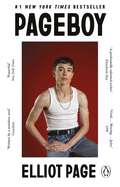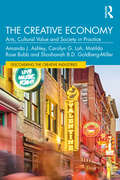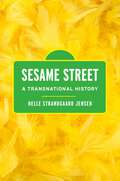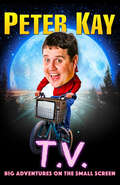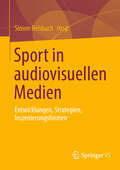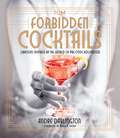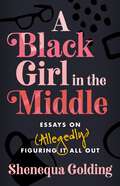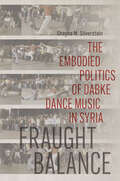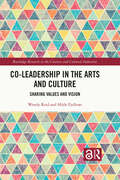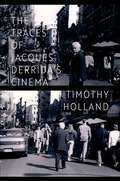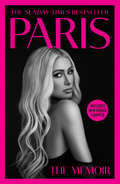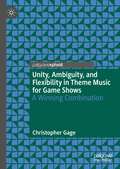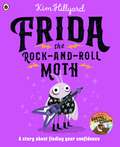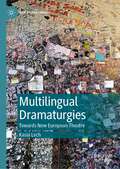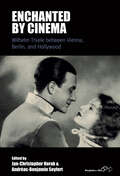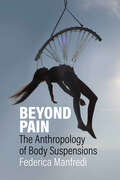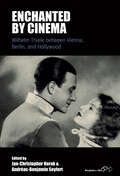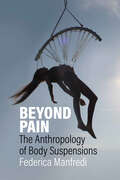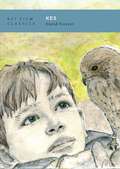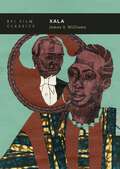- Table View
- List View
Pageboy: A Memoir: The Instant Sunday Times Bestseller
by Elliot Page#1 NEW YORK TIMES BESTSELLERINSTANT SUNDAY TIMES BESTSELLER'Singular' Daily Telegraph'Powerful' New York Times'Vital' i'Vivid… Moving… Juicy' NPR'A profoundly talented writer' Elizabeth Day'Raw, harrowing, and often heartbreaking' LA Times'Written by a sensitive soul' GuardianBefore the world premiere of Juno Elliot Page was on the edge of self-discovery. But with Juno's massive success and his dreams coming true, Elliot found himself trapped by the spotlight and the pressure to perform was suffocating him. Until enough was enough. From chasing down secret love affairs to battling body image and working through his difficult childhood, Pageboy is a beautiful, intimate book about searching for ourselves and our place in the world.'An emotional read, delivered in image-drenched prose.' Washington Post'The emergence of our true selves is all of our life's work. Pageboy helps chart the course.' Jamie Lee Curtis'Pageboy is like listening to a friend... Now is an excellent time to read this humanizing and well-written memoir.' Associated Press
The Creative Economy: Arts, Cultural Value and Society in Practice (Discovering the Creative Industries)
by Amanda J. Ashley Carolyn G. Loh Matilda Rose Bubb Shoshanah B.D. Goldberg-MillerThe creative economy permeates our everyday lives, shaping where we live, what we buy, and how we interact with others. Looking at dimensions of people, place, policy, and market forces, the book offers a comprehensive perspective on arts and culture, in both economic and social life.The book explores the multifaceted components that make up this complex field. Underlying this journey is the throughline of diversity, equity, and inclusion as watchwords of today’s global paradigm. Capital, gentrification, pay disparities, and the hegemonic confines of cultural production are a few of the key issues analyzed. Using case studies and stories of artists and creatives from the worlds of fashion, design, music, and the media arts, the book also delves into gastronomy, literature, architecture, and theatre—presenting a nuanced look at the ways in which the creative sector impacts the world today. Readers will benefit from features such as key takeaways, discussion questions, and activities, throughout the chapters.Students, scholars, policymakers, and the general public will find this a valuable resource. This book offers the reader a chance not only to understand the cultural and creative industries, but to internalize its elements and embrace the creative spirit that imbues the sector.
The Creative Economy: Arts, Cultural Value and Society in Practice (Discovering the Creative Industries)
by Amanda J. Ashley Carolyn G. Loh Matilda Rose Bubb Shoshanah B.D. Goldberg-MillerThe creative economy permeates our everyday lives, shaping where we live, what we buy, and how we interact with others. Looking at dimensions of people, place, policy, and market forces, the book offers a comprehensive perspective on arts and culture, in both economic and social life.The book explores the multifaceted components that make up this complex field. Underlying this journey is the throughline of diversity, equity, and inclusion as watchwords of today’s global paradigm. Capital, gentrification, pay disparities, and the hegemonic confines of cultural production are a few of the key issues analyzed. Using case studies and stories of artists and creatives from the worlds of fashion, design, music, and the media arts, the book also delves into gastronomy, literature, architecture, and theatre—presenting a nuanced look at the ways in which the creative sector impacts the world today. Readers will benefit from features such as key takeaways, discussion questions, and activities, throughout the chapters.Students, scholars, policymakers, and the general public will find this a valuable resource. This book offers the reader a chance not only to understand the cultural and creative industries, but to internalize its elements and embrace the creative spirit that imbues the sector.
Sesame Street: A Transnational History
by Helle Strandgaard JensenIn Sesame Street: A Transnational History, author Helle Strandgaard Jensen tells the story of how the American television show became a global brand. Jensen argues that because the show's domestic production was not financially viable from the beginning, Sesame Street became a commodity that its producers assertively marketed all over the world. Sesame Street: A Transnational History combines archival research from seven countries, bolstering an insightful analysis of how local reception and rejection of the show related to the global sales strategies and American ideals it was built upon. Contrary to the producers' oft-publicized claims of Sesame Street's universality, the show was heavily shaped by a fixed set of assumptions about childhood, education, and commercial entertainment. This made sales difficult as Sesame Street met both skepticism and direct hostility from foreign television producers who did not share these ideals. Drawing on insights from new histories about childhood, education, and transnational media, the book lays bare a cultural clash of international proportions rooted in divergent approaches to children's television. In doing so, it provides a reflective backdrop to the many ongoing debates about children's media. In contrasting the positive receptions and renunciations of Sesame Street, Jensen demonstrates that it was only after a substantial rethinking of Sesame Street's aims and business model that this program ended up on numerous broadcasting schedules by the mid-1970s. Along the way, this rethinking and the constant negotiations with potential international buyers created and shaped the business and corporate brand that paved the way for the Sesame Street we know today.
T.V.: Big Adventures On The Small Screen
by Peter KayTHE INSTANT SUNDAY TIMES BESTSELLER *The long-awaited return of the comedy national treasure*
Sport in audiovisuellen Medien: Entwicklungen, Strategien, Inszenierungsformen
by Simon RehbachDer Sammelband befasst sich mit der gegenwärtigen Darstellung von Sport in audiovisuellen Medien und erörtert verschiedene Bedingungen und Verfahren in Bezug auf sportliche Wettkämpfe wie auch Akteur_innen in Fernsehen und Internet. Die Beiträge widmen sich aus mehreren medien- und kommunikationswissenschaftlichen Perspektiven unter anderem Live-Übertragungen von Sport, 360-Grad-Videos, dem eSport, der Tätigkeit von TV-Expert_innen, der Darstellung von Fußballtrainer_innen, Instagram-Videos und dem Personal Branding von Sportler_innen.
Gudetama Cross-Stitch: 30 Easy-to-Follow Patterns from Your Favorite Lazy Egg
by Sosae Caetano Dennis CaetanoGudetama Cross-Stitch combines cross-stitching fun with 30 easy-to-follow patterns inspired by everyone's favorite lazy egg with the can't-be-bothered attitude. Gudetama&’s name literally translates to &“lazy egg,&” and it&’s how we all feel sometimes when it comes to, well, pretty much anything. But if you&’re the kind of person who doesn&’t have time for complicated crafts or dealing with other people, then this collection of 30 Gudetama-inspired designs are just for you. First, you&’ll learn cross-stitching basics including tools and techniques and how to read a cross-stitch chart. Then you&’ll apply your new skills to a range of hilarious and lovable patterns organized into chapters like Lazy, Medium-Lazy, and Pay Attention—depending on how sluggish or motivated you&’re feeling. Finally, you&’ll be able to apply your masterpieces to projects like gift tags, greeting cards, and ornaments. Whether you&’re an experienced cross-stitcher or new to the craft, you&’ll find a variety of poses and patterns in this book that are accessible and easy to learn. With a little patience and practice, anyone can bring these Gudetama-inspired masterpieces to life. And if not, just take a nap.
Forbidden Cocktails: Libations Inspired by the World of Pre-Code Hollywood
by André DarlingtonA stunning package for classic film buffs and drinks enthusiasts alike, all the &“forbidden&” fun of Pre-Code Hollywood and the Prohibition and speakeasy era meet in this stylish cocktail book. What might Jean Harlow have sipped for Dinner at Eight? What did Barbara Stanwyck take to steel herself in Baby Face? If you&’re a classic film fan who&’s ever pondered these questions, or are a bartender or at-home entertainer who adores Prohibition-era cocktails, this guide to mixed drinks inspired by Pre-Code Hollywood is essential reading. The stars and stories of the &“forbidden&” time in moviemaking before strict censorship was enforced and the movies reflected a raucous freedom that would be unseen again for decades take the spotlight in Forbidden Cocktails. With 50 film-and-drink pairings and packaged handsomely with more than 100 full-color and black-and-white photos throughout, this is a practical and stunning homage to a singularly exuberant and evocative era. Movie-and-cocktail pairings include: The Divorcee / Balanced Account; Hell&’s Angels / Platinum Blonde; Dracula / Count Draiquiri; Strangers May Kiss / Stranger&’s Kiss; The Public Enemy / Tom Powers; Night Nurse / My Pal Rye; Shanghai Express / Shanghai Lily; Scarface / First Ward; One Way Passage / Passage to Paradise; Trouble in Paradise / Lubitsch Touch; Call Her Savage / Greenwich Village; Sign of the Cross / Naked Moon; Gold Diggers of 1933 / Pettin&’ in the Park; Flying Down to Rio / Hotel Hibiscus; It Happened One Night / It Happened One Morning; The Thin Man / Asta
A Black Girl in the Middle: Essays on (Allegedly) Figuring It All Out
by Shenequa Golding'Growing up in Queens, I didn't know being named Shenequa was considered "ghetto" or uncouth. It was only later in life that I realized I was being judged by a decision I had no control over... I will examine the double-standard Black girls with big names like Shenequa face, and the quick math we have to calculate when trying to de-escalate drama.'In A BLACK GIRL IN THE MIDDLE, a timely, compelling, and blazingly honest essay collection, Shenequa Golding holds up her magnifying glass to both her own experiences and those of young Black women everywhere. With her trademark wit and originality, Shenequa covers identity-searching themes of white supremacy, feminism, misogyny, love, sex and heartbreak. But this isn't just a book about Black women's trauma, it is also a book that embraces and celebrates the things that make Black women different. For readers of SLAY IN YOUR LANE, Candice Brathwaite and Issa Rae.
Fraught Balance: The Embodied Politics of Dabke Dance Music in Syria (Music / Culture)
by Shayna M. SilversteinDabke, one of Syria's most beloved dance music traditions, is at the center of the country's war and the social tensions that preceded conflict. Drawing on almost two decades of ethnographic, archival, and digital research, Shayna M. Silverstein shows how dabke dance music embodies the fraught dynamics of gender, class, ethnicity, and nationhood in an authoritarian state. The book situates dabke politically, economically, and historically in a broader account of expressive culture in Syria's recent (and ongoing) turmoil. Silverstein shows how people imagine the Syrian nation through dabke, how the state has coopted it, how performances of masculinity reveal—and play with—the tensions and complexities of the broader social imaginary, how forces opposed to the state have used it resistively, and how migrants and refugees have reimagined it in their new homes in Europe and the United States. She offers deeply thoughtful reflections on the ethnographer's ethical and political dilemmas on fieldwork in an authoritarian state. Silverstein's study ultimately questions the limits of authoritarian power, considering the pleasure and play intrinsic to dabke circles as evidence for how performance cultures sustain social life and solidify group bonds while reproducing the societal divides endemic to Syrian authoritarianism.
Co-Leadership in the Arts and Culture: Sharing Values and Vision (Routledge Research in the Creative and Cultural Industries)
by Wendy Reid Hilde FjellværThis book is about co-leadership: A leadership practice and structure often found in arts organizations that consist of two or three executives who bridge the art and business divide at the top.Many practitioners recognize this phenomenon but the research on this topic is limited and dispersed. This book assembles a coherent overview and presents new insights of the field. While co-leadership is well institutionalized in the West, it is also criticized for management’s constraint of artistic autonomy and for its pluralism that dilutes leadership clarity. However, co-leadership also personifies the strategic objectives of art, audiences, organization, and community, by addressing plural logics – navigating the demands of artistic vision and organizational stability. It is an integrating solution. The authors investigate its specifics in the arts, including global practice and its interdisciplinary nature. The theoretical frame of plural leadership supports their empirical explorations of the dynamics within the co-leadership relationship and with organizational stakeholders. Data includes the voices of co-leaders, artists, staff, and board members from arts organizations in Canada and Norway. Their abductive reflection generates a stimulating research experience.By viewing co-leadership in action, not as a study of static theories, the book will appeal not only to students and researchers but also resonate with practitioners in arts and cultural management and assist them to work with co-leadership and to manage its tensions.
The Traces of Jacques Derrida's Cinema
by Timothy HollandSituated at the intersection of film and media studies, literary theory, and continental philosophy, The Traces of Jacques Derrida's Cinema provides a trenchant account of the role of cinema in the oeuvre of one of the most influential philosophers of the twentieth century, Jacques Derrida (1930-2004). The book is animated by Derrida's self-confessed passion for the movies, his reluctance to write about film despite the range of his corpus, and the generative encounters arising between his legacy and the field of film and media studies as a result. Given the expanse of its references, interdisciplinarity, and consideration of Derrida's approach to the experience of both spectatorship and the act of being filmed, The Traces of Jacques Derrida's Cinema contributes to the ongoing close analyses of the philosopher's work while also providing a rigorous introduction to deconstruction. Author Timothy Holland interweaves historical and speculative modes of research and writing to articulate the peripheral-yet surprisingly crucial-place of the cinematic medium for Derrida and his philosophical enterprise. The outcome is a meticulously detailed survey of the centers and margins of Derrida's oeuvre that include forays into such terrain as: his notable appearances in films; an unrealized project on cinema and belief that Derrida proposed in a 2001 interview; the correspondences between the strategies of deconstruction and the traditions, homecomings, and wordplay of David Lynch's cinematic media; and the questions wedded to the future of film studies amid the vicissitudes of the modern, virtual university. Ultimately, Holland pursues the thinking activated by the flickering of Derrida's cinema-not only the absence and presence of film in Derrida's professional and personal life, but also the rigor of academic discourse and the pleasures of the movies, ghosts and technology, religious faith and scientific knowledge, and ruination and survival-as a critical chance for reflection.
Paris: The Memoir
by null Paris HiltonPARIS: A MILLION MEANINGS IN A SINGLE NAME Heiress. Party girl. Problem child. Selfie taker. Model. Reality star. Self-created. The labels attached to Paris Hilton. Founder. Entrepreneur. Pop Culture Maker. Innovator. Survivor. Activist. Daughter. Sister. Wife. Mother. The roles Paris embraces as a fully realized woman. Paris rose to prominence as an heiress to the Hilton hotel empire but cultivated her fame and fortune as the IT Girl of the aughts, a time marked by the burgeoning 24-hour entertainment news cycle and the advent of the celebrity blog. Using her celebrity brand, Paris set in motion her innovative business ventures, while being the constant target of tabloid culture that dismissively wrote her off as “famous for being famous.” With tenacity, sharp business acumen and grit, she built a global empire and, in the process, became a truly modern icon beloved around the world. Now, with courage, honesty, and humour, Paris Hilton is ready to take stock, place it all in context and share her story with the world. Separating the creation from the creator, the brand from the ambassador, Paris: The Memoir strips away all we thought we knew about a celebrity icon, taking us back to a privileged childhood lived through the lens of undiagnosed ADHD, a teenage rebellion that triggered a panicked – and perilous – decision by her parents. Led to believe they were saving their child’s life, Paris’s mother and father had her kidnapped and saw her sent to a series of ‘emotional growth boarding schools’, where she survived almost two years of verbal, physical and sexual abuse. In the midst of a hell we now call the ‘troubled teen industry’, Paris created a beautiful inner world where the ugliness couldn’t touch her. She came out, resolving to trust no-one but herself as she transformed that fantasy world into a multibillion-dollar reality. Recounting her perilous journey through pre-#MeToo sexual politics with grace, dignity and just the right amount of sass. Paris: The Memoir tracks the evolution of celebrity culture through the story of the figure at its leading edge, full of defining moments and marquee names. Most important, Paris shows us her path to peace while she challenges us to question our role in her story and in our own. Welcome to Paris.
Unity, Ambiguity, and Flexibility in Theme Music for Game Shows: A Winning Combination
by Christopher GageWith flashing lights, bright colors, and big money, game shows have been an integral part of American culture since the days of radio. While the music that accompanies game shows is charming and catchy, it presents two unique, opposing challenges: first, it must exhibit unity in its construction so that, at any point and for any length of time, it is a tuneful, recognizable signifier of the show to which it belongs; at the same time, it must also possess the ability to be started and stopped according to the needs of gameplay without seeming truncated. This book argues that game show music, in particular from 1960 to 1990, deploys a variety of shared techniques in order to manage these two goals, including theme-derived vamps; saturation of motivic material; and harmonic, rhythmic, and formal ambiguity. Together, these techniques make game show themes exciting, memorable, and perfectly suited to their role.
Frida the Rock-and-Roll Moth: A story about finding your confidence
by Kim HillyardA NEW picture book from the winner of the Best Illustrated Book, Waterstones Children's Prize 2023.Frida is a musical moth who loves to rock out - she puts on her pointy boots and plays her purple guitar really LOUD! But when the Big Bright Light is switched on, more moths appear, ready to rock together, and Frida starts to feel that everyone is much better than her. Perhaps she isn't so rock-and-roll after all . . .With the help of her biggest fan, Auntie Edna, Frida learns to reclaim her style, find her confidence and get up and rock on once more!This positive picture book will inspire readers to find what makes them feel good and let their inner confidence shine.Kim Hillyard creates positive, heart-warming stories that are designed to empower and inspire young readers. Each picture book focuses on a different feeling or belief to help children navigate the world around them.Also available from Kim Hillyard:Mabel and the Mountain: a story about believing in yourselfNed and the Great Garden Hamster Race: a story about kindnessGretel The Wonder Mammoth: a story about overcoming anxietyFlora and Nora Hunt for Treasure: a story about the power of friendship
Multilingual Dramaturgies: Towards New European Theatre (New Dramaturgies)
by Kasia LechMultilingual Dramaturgies provides a study of dramaturgical practices in contemporary multilingual theatre in Europe. Featuring interviews with international theatremakers, the book gives an insight into diverse approaches towards multilingual theatre and its dramaturgy that reflect cultural, political, and economic landscapes of contemporary Europe, its inhabitants, and its theatres. First-hand accounts are contextualized to reveal a complex set of negotiations involved in the creative and political tasks of staging multilingualism and engaging the audience, as well as in practical issues like funding and developing working models. Using interviews with practitioners from a diverse range of theatrical backgrounds and career levels, and with various models of financial support, Multilingual Dramaturgies also offers an insight into different attitudes towards multilingualism in European theatres. The book illuminates not only the potential for multilingual dramaturgies, but also the practical and creative difficulties involved in making them. By bringing the voices of artists together and providing a critical commentary, the book reveals multilingual dramaturgies as webbed practices of differences that also offer new ways of understanding and performing identity in a European context. Multilingual Dramaturgies sheds light on an exciting theatre practice, argues for its central role in Europe and highlights potential directions for its further development.
Enchanted by Cinema: Wilhelm Thiele between Vienna, Berlin, and Hollywood (Film Europa #29)
by Jan-Christopher Horak and Andréas-Benjamin SeyfertWilliam Thiele is remembered today as the father of the sound film operetta with seminal classics such as Drei von der Tankstelle (1930). While often considered among the most accomplished directors of Late Weimar cinema, as an Austrian Jew he was vilified during the onset of the Nazi regime in 1933 and fled to the United States where he continued making films until the end of his career in 1960. Enchanted by Cinema closely examines the European musical film pioneer’s work and his cross-cultural perspective across forty years of filmography in Berlin and Hollywood to account for his popularity while discussing issues of ethnicity, exile, comedy, music, gender, and race.
Beyond Pain: The Anthropology of Body Suspensions
by Federica ManfrediThe practice of body suspension — piercing one’s own flesh with metal hooks and hanging from them — and its uniquely sprawling community challenge our cultural understanding of pain. The suspendees experience physical suffering to trigger altered states of consciousness that help them define and create an enhanced version of the self. Through experimental and practice-based methodology, Beyond Pain combines thirteen years of intermittent ethnographical fieldwork during suspension festivals and private events in Italy, Portugal, and Norway, along with online sites such as Facebook groups, to uncover the often silenced and misunderstood voices of the people who undertake this practice.
Enchanted by Cinema: Wilhelm Thiele between Vienna, Berlin, and Hollywood (Film Europa #29)
by Jan-Christopher Horak Andréas-Benjamin SeyfertWilliam Thiele is remembered today as the father of the sound film operetta with seminal classics such as Drei von der Tankstelle (1930). While often considered among the most accomplished directors of Late Weimar cinema, as an Austrian Jew he was vilified during the onset of the Nazi regime in 1933 and fled to the United States where he continued making films until the end of his career in 1960. Enchanted by Cinema closely examines the European musical film pioneer’s work and his cross-cultural perspective across forty years of filmography in Berlin and Hollywood to account for his popularity while discussing issues of ethnicity, exile, comedy, music, gender, and race.
Enchanted by Cinema: Wilhelm Thiele between Vienna, Berlin, and Hollywood (Film Europa #29)
by Jan-Christopher Horak Andréas-Benjamin SeyfertWilliam Thiele is remembered today as the father of the sound film operetta with seminal classics such as Drei von der Tankstelle (1930). While often considered among the most accomplished directors of Late Weimar cinema, as an Austrian Jew he was vilified during the onset of the Nazi regime in 1933 and fled to the United States where he continued making films until the end of his career in 1960. Enchanted by Cinema closely examines the European musical film pioneer’s work and his cross-cultural perspective across forty years of filmography in Berlin and Hollywood to account for his popularity while discussing issues of ethnicity, exile, comedy, music, gender, and race.
Beyond Pain: The Anthropology of Body Suspensions
by Federica ManfrediThe practice of body suspension — piercing one’s own flesh with metal hooks and hanging from them — and its uniquely sprawling community challenge our cultural understanding of pain. The suspendees experience physical suffering to trigger altered states of consciousness that help them define and create an enhanced version of the self. Through experimental and practice-based methodology, Beyond Pain combines thirteen years of intermittent ethnographical fieldwork during suspension festivals and private events in Italy, Portugal, and Norway, along with online sites such as Facebook groups, to uncover the often silenced and misunderstood voices of the people who undertake this practice.
Beyond Pain: The Anthropology of Body Suspensions
by Federica ManfrediThe practice of body suspension — piercing one’s own flesh with metal hooks and hanging from them — and its uniquely sprawling community challenge our cultural understanding of pain. The suspendees experience physical suffering to trigger altered states of consciousness that help them define and create an enhanced version of the self. Through experimental and practice-based methodology, Beyond Pain combines thirteen years of intermittent ethnographical fieldwork during suspension festivals and private events in Italy, Portugal, and Norway, along with online sites such as Facebook groups, to uncover the often silenced and misunderstood voices of the people who undertake this practice.
Kes (BFI Film Classics)
by David ForrestKen Loach's 1969 drama Kes, considered one of the finest examples of British social realism, tells the story of Billy, a working class boy who finds escape and meaning when he takes a fledgling kestrel from its nest.David Forrest's study of the film examines the genesis of the original novel, Barry Hines' A Kestrel for a Knave (1968), the eventual collaboration that brought it to the screen, and the film's funding and production processes. He provides an in depth analysis of key scenes and draws on archival sources to shed new light on the film's most celebrated moments. He goes on to consider the film's lasting legacy, having influenced films like Ratcatcher (1999) and This is England (2006), both in terms of its contribution to film history and as a document of political and cultural value. He makes a case for the film's renewed relevance in our present era of systemic economic (and regional) inequality, alienated labour, increasingly narrow educational systems, toxic masculinity, and ecological crisis. Kes endures, he argues, because it points towards the possibility for emancipation and fulfilment through a more responsive and nurturing approach to education, a more delicate and symbiotic relationship with landscape and the non-human, and an emotional articulacy and sensitivity shorn of the rigid expectations of gender.
Xala (BFI Film Classics)
by James S. WilliamsXala (1974) by the pioneering Senegalese director Ousmane Sembene, was acclaimed on its release for its scorching critique of postcolonial African society, and it cemented Sembene's status as a wholly new kind of politically engaged, pan-African, auteur film-maker. Centring on the story of businessman El Hadji and the impotence that afflicts him on his marriage to a young third wife, Xala vividly captures the cultural and political upheaval of 1970s Senegal, while suggesting the radical potential of dissent, solidarity and collective action, embodied by El Hadji's student daughter Rama and the group of urban 'undesirables' who act as a kind of raw chorus to the affairs of the neocolonial elite. James S. Williams's lucid study traces Xala's difficult production history and analyses its daring combination of political and domestic drama, oral narrative, social realism, symbolism, satire, documentary, mysticism and Marxist analysis. Yet from its dazzling extended opening sequence of revolution as performance to its suspended climax of redemption through ritualised spitting, Xala presents a series of conceptual and formal challenges that resist a simple reading of the film as allegory. Highlighting often overlooked elements of Sembene's intricate, experimental film-making, including provocative shifts in mood and poetic, even subversively erotic, moments, Williams reveals Xala as a visionary work of both African cinema and Third Cinema that extended the parameters of postcolonial film practice and still resounds today with its searing inventive power.
Xala (BFI Film Classics)
by James S. WilliamsXala (1974) by the pioneering Senegalese director Ousmane Sembene, was acclaimed on its release for its scorching critique of postcolonial African society, and it cemented Sembene's status as a wholly new kind of politically engaged, pan-African, auteur film-maker. Centring on the story of businessman El Hadji and the impotence that afflicts him on his marriage to a young third wife, Xala vividly captures the cultural and political upheaval of 1970s Senegal, while suggesting the radical potential of dissent, solidarity and collective action, embodied by El Hadji's student daughter Rama and the group of urban 'undesirables' who act as a kind of raw chorus to the affairs of the neocolonial elite. James S. Williams's lucid study traces Xala's difficult production history and analyses its daring combination of political and domestic drama, oral narrative, social realism, symbolism, satire, documentary, mysticism and Marxist analysis. Yet from its dazzling extended opening sequence of revolution as performance to its suspended climax of redemption through ritualised spitting, Xala presents a series of conceptual and formal challenges that resist a simple reading of the film as allegory. Highlighting often overlooked elements of Sembene's intricate, experimental film-making, including provocative shifts in mood and poetic, even subversively erotic, moments, Williams reveals Xala as a visionary work of both African cinema and Third Cinema that extended the parameters of postcolonial film practice and still resounds today with its searing inventive power.
